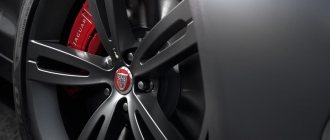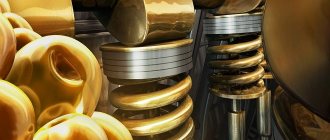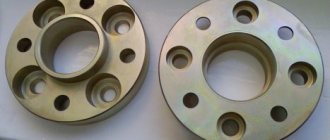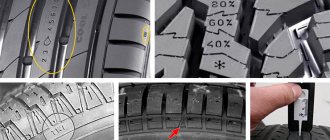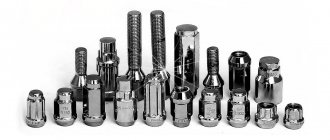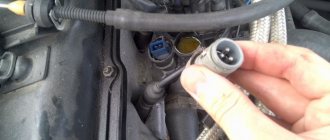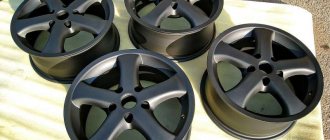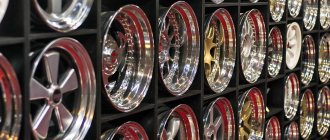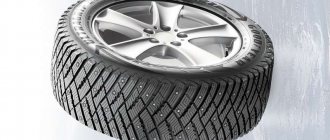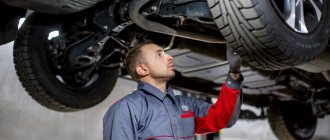The topic of this review will be the marking of car rims and deciphering their designations for passenger cars and other types of transport. This aspect is very important when replacing tires and wheels. After all, an incorrectly selected product worsens many different indicators of a vehicle: adhesion to the surface, exceeding the maximum load on the suspension, vehicle controllability, and service life. If installation is carried out for an unsuitable vehicle model, there is a serious danger to the life of the driver. Therefore, you should be extremely careful and learn to correctly read information from the manufacturer. Read on to find out where to find them and how to interpret them correctly.
Wheel rim markings - explanation
There are several methods for applying information. But the presentation form remains the same. In most cases, the standard certified European method, un/ece 124, is used for both stamping and casting. Although there are exceptions, which we will discuss below.
You can visually find the necessary information on the rim; they are located on the outer or inner side, depending on the manufacturer. It is important to understand that this data relates to basic information only. There are also additional ones that are applied to some types of goods. They are not always found, for example, the maximum tire pressure or the load on the resource. Let's see how it looks on the diagram.
Additional markings
In addition to standard designations, when choosing disks you may come across the following abbreviations:
- MAX LOAD – a parameter that shows what maximum load is allowed on the disks;
- MAX PSI 50 COLD - indicates that the tire pressure should not exceed 3.5 kgf/sq.cm. COLD is a reminder that the tire pressure should only be measured when the tire is cold;
- FORGET – indicates that the disc was made by forging;
- BEADLOCK – the disc is equipped with a tire locking device. It is prohibited to use such products;
- BEADLOCK SIMULATOR – states that the disk is equipped with a system that simulates a “beadlock”. This element is rather decorative in nature, so such models are no different from ordinary disks;
- SAE/ISO/TUV is a marking of a regulatory body indicating that products comply with international standards.
In addition, the disc may indicate the date of manufacture. The first two digits are the week, and the subsequent ones are the year. For example, 0510 means that the product left the assembly line in the 5th week of 2010.
Marking of car disks and its decoding
To make the information sufficiently detailed, let’s try to understand everything using an example. Let's take as a basis this entry that we can find on the disk: 6.5Jx15 H2 5/100 ET45 d54.1. And after that, step by step, we will consider each of the digital and letter values, we will find out how important this or that parameter will be.
Rim width
This is the distance from one edge to the other. It is read on the inside; on the outside there may be a different value. This aspect is very important, because it plays a serious role when choosing a tire. Each has its own acceptable range, which should be used to navigate. Moreover, you should not get too close to the boundaries of the parameter. In our case, the width in inches is 6.5. And it is this middle range that the tire should have.
If 6.5 is the lateral value, the minimum or maximum for the tire, then, of course, it can be allowed for use, but the service life will be significantly reduced.
Rim edge type
As we can see, after the width we have the letter J. And it tells us all the necessary information about the type. That is, the shape of the edge, the place of traction with the tire. And if the view is inappropriate, then the connection will be less reliable. And this plays a role during installation, affects the mass of the balancers, as well as the displacement of rubber from its axis if a sharp maneuver is performed or there is an unfavorable external environment. And in an emergency, a small miscalculation in the shape of the edge can cost a person’s life.
J is the most common species in the Russian Federation. Second place is held by the JJ, designed for all-wheel drive vehicles. But it would be wrong to use one on a machine designed for the other. What can we say about other types, such as P, D, B, K, which differ in the form of the clutch quite significantly.
Rim connector
So, if we look at the designations of car rims, the next parameter is the letter X. It tells us that the specified type does not have a detachable design. In other words, it cannot be disassembled into its component parts - it is a monolithic whole. Such a rim has enough advantages - greater rigidity, and from a structural point of view, installation difficulties will be much less. But at the same time, it is permissible to use this type only with elastic tires, which is suitable for passenger cars. With rare exceptions, this may be a small truck. But large machines use only detachable types, otherwise it is not possible to install the tire.
Mounting diameter
The number 15 shown in our example. Represents the size of the seat on the rim for the tire. And it must strictly comply with the tire parameters. Otherwise, serious difficulties will arise during installation. And dissimilar types are not allowed in operation. You won’t be able to play with this value; purchase only if it matches exactly. Nowadays, models from 13 to 21 are common. Small for minicars and large for impressive trucks and special equipment.
Ring lugs
They are also often called humps (from the English word “hump”). These are small protrusions that are necessary when using tubeless tires. They rest against it, preventing depressurization during maneuvers. If external forces press on the rubber, then without special ledges they will become deformed and the air will begin to escape. Accordingly, the wheel will simply go flat.
So, the markings of automobile alloy wheels are deciphered for passenger cars:
- H. Hump is present in a single copy. This indicates simple installation; pulling a tire onto one protrusion is not difficult at all. Even a non-professional can do it.
- H2. And this is already a double hump. The protrusions are located on both sides, internal and external. And here serious difficulties arise with installation. Therefore, special tools will have to be used.
- FH. This is a flat type of tackle. Infrequently used, but also difficult to install.
- A.H. Asymmetrical look. This is the golden mean, one of the protrusions is larger than its counterpart. Accordingly, it will be much easier to tighten the rubber. At the same time, reliability does not suffer much; the level of possible air leakage in extreme situations is approximately the same as that of the H2.
Location of fasteners
In our version, the value is set to 5*100. This means that 5 bolts with a circle diameter of 100 millimeters are needed. This factor usually plays a cruel joke on beginners who try to simply visually determine the size of the fastener and select the appropriate one. After all, they vary in a fairly wide range from 98 to 139 millimeters. And a mistake of even one mm will lead to very unpleasant consequences. Over time, the bolt itself will begin to loosen, because the seat is too large for it. Otherwise, during installation, it will either not fit completely into the thread, or it will be twisted. And this will again lead to loosening and failure of the fasteners at the most inopportune moment.
Therefore, focus only on specific numbers and select products in strict accordance with them. Fortunately, we have all the information, and deciphering the writing on the disks is quite simple. No specific skills required.
Disc offset
Is the distance from the point of contact with the hub to the cross-sectional plane. It is curious that this meaning can take on both positive and negative forms. In the presented version, it looks like ET 45. That is, positive. But there are types such as ET -30, which is already a negative value.
It is important when selecting a purchase at this point not to rely on ranges. Select only exact products that fully comply with the manufacturer’s specifications. Otherwise, if a situation arises when external forces put pressure on the wheel, for example, a sharp turn or a small collision, the disc will crack. And there are also frequent cases when it simply splits on the move. It pays to be careful.
Landing slot diameter
Indicated in the example under the Latin letter d. Indicated in mm. In principle, you won’t be able to play with the parameters here either. It's simple: during installation, the product will not sit in its slot if it is selected incorrectly. Of course, it will not bring dangers on the road, because it cannot even be installed. But the purchase will have to be exchanged for a new one. This is why markings on wheel rims, deciphering symbols and all parameters is such an important aspect.
Fasteners
Only bolts of the appropriate size are used. The quantity varies depending on the model. Maybe 4 or 6. But there are also exotic options of 3, 5, and there are also 9 bolts. But for a typical passenger vehicle in the Russian Federation, you need to focus on 4 and 6. But the sizes vary, and as already mentioned, here you should choose exactly not even up to a millimeter, but up to a tenth of it. Otherwise, the fastener resource will be consumed several times faster. And although the bolt itself is inexpensive, it is important to know at what point it is time to change it. Usually this is done only in conjunction with a complete replacement of the entire structure. And if the size does not match, it will fail much earlier and an unfavorable moment will arise for driving the vehicle. This is why wheel markings and decoding information on the rim are so important.
An interesting fact is that with an even number of fasteners, the distance between them is strictly the same. But if it’s odd, the distance from one bolt to another increases by a factor of 1.051.
We would also like to draw your attention to the fact that now there are models that are suitable for several types of transport at once. They are indicated in a range, 100/110 or 100/120 and so on. This means that the design is universal and will fit fasteners of any diameter in the stated range. True, the service life in this case will still be somewhat reduced, but not particularly significantly.
Standard marking of a car wheel
The parameters of wheel rims, which will not take much time to decipher, are abbreviations that are the same all over the world for cast or forged wheels. There are also no divisions by type of car as such, since the marking is the same for all vehicles.
In order to quickly understand the notations, let's look at them using an example: 7.5 J x 16 H2 4x98 ET45 d54.1. Based on this information, we can see the following markings.
Rim width
The first number is responsible for this parameter - 7.5, indicating the distance between the inner edges of the rim. The fact is that each tire has a certain rim width range, which is measured in inches. Therefore, it is better to select wheels whose rim width is approximately in the middle of this range.
Rim edge type
In this case, the letter J tells us about the type of edge - the designation of the shape of the edge of the rim. This is where the disc connects to the tire. The following letter combinations may also occur: JJ, JK, K, B, D, P. It is difficult to say exactly what profile each of these letters represents, since in European standards the description of all these combinations is very large and rather ambiguous. Each symbol may indicate the shape or radius of the contour, and in some situations it may indicate the angle of inclination of the rim flanges. Therefore, we will consider only the most popular and well-known. JJ indicates that this is an SUV wheel. If the letter K is written, then this is the best option for a Jaguar car, and P and B are most often installed on Volkswagen Beetles. If we talk about trucks, then the following group of letter symbols is responsible for this category: E, F, G, H.
Rim connector
The X symbol means that in this case the rim is one-piece, that is, it is a single part. But if you notice the “-” sign, then this is a model consisting of several parts, thanks to which it can be disassembled and reassembled. One-piece discs are considered the best, since in this case their design is much lighter and more rigid. Another advantage of one-piece models is the ability to install elastic tires on them. If we are talking about hard tires, which are most often equipped with trucks, then preference should be given, on the contrary, to split rims, otherwise you simply will not be able to install the tire on the rim.
Mounting diameter
Continuing to look at the parameters of the wheels on the car, we see the number 16, which is responsible for the mounting diameter of the wheel rim, corresponding to the mounting size of the tire. The rim flange is not considered in this case. Therefore, there are standard values for this parameter from 10 to 19 inches.
Ring projections (rolls)
In the example, H2 means that in this case we have a certain type of structure, consisting of humps located on both sides, which are designed for more reliable fixation of tubeless tires. In this case, there is no outflow of air (in the case of lateral impact on the tire). In a situation where there is an H mark on the disk, this will mean that the hump is located on only one side. The following letter variations also exist:
- FH – flat hump;
- AH – asymmetrical;
- CH – combined;
- SL – there are no humps in the design (in this case the tire will hold on to the edges of the rim).
Location of mounting holes
This parameter is indicated by the symbols 4x98, where the first number tells us the number of mounting holes, and the number 98 is the diameter of the circle itself, the center of which is located in the same place as the center of the disk. Usually the number of such holes is from 4 to 6, although sometimes you can find models with 3, 8, 10 pieces.
We recommend: We select spark plugs Denso, NGK, Bosh, Beru, Champion by car make
The standard value for the circle diameter can be in the range from 98 to 139.7.
When choosing disks based on this parameter, many car enthusiasts make one common mistake - they try to determine by eye the size of the hub and the disk. As a result, having installed a 98 disc instead of a 100, they are faced with the fact that the wheels are simply warped. As a result, the bolts begin to unscrew spontaneously.
Disc offset
ET45 in our example is a value indicating the distance between the plane that passes through the center of the cross section of the disk and the plane located in the contact zone between the disk and the hub.
Disc failure occurs:
- Positive when the plane of symmetry of the car disk is located further from the center of the car, compared to the mating plane;
- Negative when, on the contrary, the mating plane is located further from the center of the machine than the plane of symmetry of the disk. Then the marking would look like ET-45;
- Zero (ET0), when the center of symmetry of the disk coincides with the mating plane.
Before choosing a disc, it is better to study the recommendations of the car manufacturer. Which should indicate in the relevant documents for the car which type of disc offset is suitable for your car model.
Bore hole diameter
d54.1 corresponds to the diameter of the central hole of the disk (measured in millimeters). The standard range for this parameter is from 50 to 70 mm for passenger cars. It is very important to select a disk that will exactly match this parameter and the size of the seating belt located on the machine hub. If it turns out that the diameter was chosen smaller, then you simply will not be able to put on the disc.
There are also additional markings on car rims, the decoding of which will be useful.
Ready-made solutions for all areas
Stores
Mobility, accuracy and speed of counting goods on the sales floor and in the warehouse will allow you not to lose days of sales during inventory and when receiving goods.
To learn more
Warehouses
Speed up your warehouse employees' work with mobile automation. Eliminate errors in receiving, shipping, inventory and movement of goods forever.
To learn more
Marking
Mandatory labeling of goods is an opportunity for each organization to 100% exclude the acceptance of counterfeit goods into its warehouse and track the supply chain from the manufacturer.
To learn more
E-commerce
Speed, accuracy of acceptance and shipment of goods in the warehouse is the cornerstone in the E-commerce business. Start using modern, more efficient mobile tools.
To learn more
Institutions
Increase the accuracy of accounting for the organization’s property, the level of control over the safety and movement of each item. Mobile accounting will reduce the likelihood of theft and natural losses.
To learn more
Production
Increase the efficiency of your manufacturing enterprise by introducing mobile automation for inventory accounting.
To learn more
EGAIS
Eliminate errors in comparing and reading excise duty stamps for alcoholic beverages using mobile accounting tools.
To learn more
RFID
The first ready-made solution in Russia for tracking goods using RFID tags at each stage of the supply chain.
To learn more
Certification for partners
Obtaining certified Cleverence partner status will allow your company to reach a new level of problem solving at your clients’ enterprises.
To learn more
Inventory
Use modern mobile tools to carry out product inventory. Increase the speed and accuracy of your business process.
To learn more
Mobile automation
Use modern mobile tools to account for goods and fixed assets in your enterprise. Completely abandon accounting “on paper”.
Learn more Show all automation solutions
How to choose the right wheel rim for your car based on key parameters
Sometimes car owners who have not had time to gain sufficient experience have to change their wheels. The task turns out to be not the easiest for them, which is worth the designations alone: 4x108, 6J, ET47, Dia 63.3, R15. So, let's talk about how to choose a wheel rim.
1. What needs to be done?
The challenge is to choose the right wheel for the car. At the same time, it is worth understanding the necessary parameters.
2. What disk parameters are important when choosing a disk?
When thinking about how to choose a wheel for any car, proceed from the following parameters:
- wheel type;
- mounting (landing) diameter;
- number, size, configuration and location of mounting holes (PCD) on the disk;
- disk width;
- departure (ET);
- diameter of the central (hub) hole;
- presence of humps;
- maximum permissible load on the wheel rim.
If, after reading the listed parameters, you change your mind about dealing with them yourself, simply contact an online service that will help you choose a wheel rim for your car. All you need to do is enter information about your car model to buy suitable wheels.
And if you are ready to further figure it out on your own, let’s continue.
3. What types of disks are there?.
Depending on the type of manufacture, discs can be stamped, cast or forged. Let's take a closer look at the main differences between them:
- The cheapest are stamped wheels; they are included in the basic equipment of budget cars and are covered with decorative plastic caps . The advantages of steel, enamel-painted wheels are low cost and repairability. As a result of mechanical stress, they are crushed, but are easily restored. The main disadvantages are heavy weight and unattractive appearance. For this type of product, functionality is primary, not design.
- Alloy wheels are no less in demand than stamped ones . Aluminum alloys are used for their manufacture. Production technology allows us to produce cast products of various shapes. A more interesting design combined with lower weight ensures demand for them among car owners. Among the disadvantages, it should be noted that they are more expensive than stamped ones, as well as difficult to repair. A strong impact can cause cracks in the wheel. And although welding and rolling technologies are used during the repair process, no one can guarantee the preservation of the characteristics and quality of the wheel after repair.
- The most expensive and high-quality are forged wheels . For their production, the method of hot die stamping is used, during which the internal structure of the metal is best preserved. They are characterized by high strength and low weight. The disadvantages are low prevalence and high cost.
In addition to the three named types, prefabricated wheel rims are also produced, but they are so rare that there is no point in dwelling on them in detail. In most cases, car owners deciding how to choose a wheel rim will have to choose between unattractive-looking, but inexpensive stamped wheels and more attractive and expensive cast wheels.
4. Mounting (landing) diameter.
This parameter is used to specify the diameter of the disc's circumference, measured in inches. The letter R is used to designate it, for example, R16 means that the diameter of the product is 16 inches.
It should be noted that the letter R itself does not mean diameter, it was borrowed from the characteristics of tires, where it is used to indicate the radius, although in reality we are talking about the landing diameter of the tire. If we talk about tires, the letter R marks the radial cord design; for wheel rims it has no actual meaning. But at the same time, erroneous values of radius and diameter with the letter R denoting them are in most cases used by default by sellers and service specialists who help to select wheels.
In order to choose the right wheel rim, refer to the operating instructions for your car or take a closer look at the sticker on the doorway; the permissible wheel diameters and recommended tire pressure are indicated there. When buying tires, do not forget that they must have a seat diameter similar to the disc one.
You should not buy wheels larger than the maximum allowable, since they may not only be geometrically incompatible with the car, but also affect the operation of the suspension, accelerating wear of the chassis. In addition, do not forget that the large diameter of the wheels in combination with low-profile tires affect the comfort of movement, which will be especially noticeable when driving on uneven roads. However, you can increase the diameter within the limits specified by the manufacturer, or by an inch more, this will not affect the operation of the car.
5. Number and diameter of mounting holes (PCD).
This parameter is called bolt pattern. It refers to the number of mounting holes and the diameter of the circle on which they are located (from the English abbreviation PCD - Pitch Circle Diameter, i.e. diameter of the circle). The number of mounting bolts may vary depending on the weight and speed of the car, most often there are from 4 to 6, but it can be either more or less (the minimum number is 3). VAZ cars have a bolt pattern of 4x98, except for the Oka with a bolt pattern of 3x98, the Niva - 5x139.7, and, for example, the Largus - 4x100.
This parameter requires compliance, although it seems that it is possible to match a model with a 4x98 bolt pattern to a wheel with a 4x100 parameter. In fact, a seemingly insignificant two-millimeter difference in the diameter of the circle on which the holes for the mounting bolts are located will make itself felt during the installation of the wheel rim. Only 1 of the 4 fasteners will be able to be tightened correctly; the rest will move relative to the center, causing the wheel to wobble. You can partially solve the problem by using bolts with a floating cone, but the best option is to select wheels with the desired bolt pattern.
We recommend
“Marking of automobile rims and tires.
How to choose the right one» More details 6. Disc width .
This parameter is used to specify the width of the product, measured in inches. Most often, the letter J is used for designation, for example, 5.5J means a wheel rim whose width is 5.5 inches.
The width of the product is usually indicated along with the permissible landing diameter. Also, the width of the rim matters when choosing tires. Tires can be used with rims of a certain width, but some tolerance is acceptable.
7. Diameter of the central (hub) hole.
There is no need to explain what is meant by the diameter of the central hole. To designate it, use the abbreviation “Dia”, “DIA” or “D”. This parameter is important, because if the central hole is too small, the wheel cannot be put in place; if it is too large, there will be a need for centering rings to center the product on the hub.
A number of car owners believe that if you choose a wheel rim with a large central hole, then during the process of tightening the bolts it will self-center on the hub. In reality this won't happen. Therefore, if wheel balancing does not correct runout and vibration, you should check whether the diameters of the central hole of the disk and the hub match.
8. Disc offset.
Disc offset means the distance between the mating plane of the disk attachment to the hub and the longitudinal axis of symmetry of the wheel. The central axis of symmetry is understood as a line that divides the disk into two halves in width, and the mating plane means the point of contact of the disk with the hub.
There are three types of departure - positive, zero and negative. When the axis of symmetry is located closer in the car compared to the mating plane, they speak of a positive offset; when they are located on the same axis, it is zero; when the axis of symmetry is further away compared to the mating plane, it is negative. That is, with a smaller offset, the disk protrudes less outside the wheel arch.
This parameter is of great importance, as it has a direct impact on the functioning of the suspension and wheel bearings. If you choose the wrong wheel rim according to the offset, you may experience faster wear of the chassis and bearings.
9. Shape of mounting holes.
The shape of the mounting holes is important for selecting bolts or nuts of the desired configuration. Stamped disks are usually fastened with bolts and nuts that have a light conical shape of the plane that is adjacent to the disk; in addition, shorter bolts are used for them, since the thickness of such a product is minimal.
Alloy wheels are thick, the mounting holes themselves have a pronounced conical shape, and accordingly, they require different bolts and nuts. In some cases, bolts or nuts with a hemispherical or flat working surface may be required.
In addition to those listed, bolts are produced that have a so-called floating cone; with their help, you can to some extent compensate for the difference in the PCD of the disk. The working conical part is a separate ring placed on the bolt and displaced relative to the longitudinal axis of the bolt during the tightening process.
10. Presence of humps.
Humps are the protrusions on the outer surface of the wheel that secure a tubeless tire. If you were present when the wheels were beaded, you probably heard loud popping sounds heard when the tire was inflated. It is at this moment that the tire bead takes the desired position between the hump and the rim flange. The vast majority of modern wheels have humps and are designed for use with tubeless tires.
But if you're thinking of picking up rims that were made many decades ago, keep in mind that they may not have humps and are intended only for tube tires. If desired, you can put tubeless tires on such rims, but a tight fit and, accordingly, driving safety cannot be guaranteed in this case. If the tire pressure is insufficient, there is a possibility that it will come off the wheel while driving.
11. Maximum load that the disk can withstand.
The parameter, designated by the letters MAX LOAD, indicates the maximum load for which the wheel rim is designed, expressed in kilograms or pounds. For example, MAX LOAD 2000LB means that the product is rated for a load of 2 thousand pounds (908 kg).
When driving, the car rests on its wheels, so it is important that they support its weight when the vehicle is fully loaded.
When deciding how to choose rims, keep in mind that those intended for the Lada will not fit the Mitsubishi Pajero. If you ignore this parameter, you will encounter deformation of the wheels and loss of their performance characteristics.
To determine the maximum load, 60% of the total vehicle weight must be divided in half. You can also check with your authorized dealer or disc manufacturing company. Forged models are able to withstand a much greater load, despite the fact that they themselves do not weigh as much.
Keep in mind that from the point of view of economic benefits, it is better to choose two sets of rims so as not to have to deal with wheel trim in the spring and autumn. This operation damages both the tires, which over time can begin to leak air at the junction with the disk, and the products themselves, which can be scratched and subsequently corroded. In addition, beading the wheels will require financial investments (several tire changes are comparable to the cost of the disk), as well as time costs, especially in case of sudden changes in weather conditions.
Two complete wheel sets will save you time, money, and extend the life of your tires and wheels.
How are alloy wheels marked?
In principle, there are no key differences. But there is one important factor that should not be overlooked. In addition to the standard data, the casting must always have a certification mark, which is applied after checking with a special x-ray. There is also a label of the organization responsible for the procedure. Usually this is not a manufacturer, but a company that has the appropriate license.
Disk options
To determine what the marking means, you need to know the width and diameter of the wheel product.
Drilling or bolting
This is one of the most difficult parameters to study, indicating the diameter of the mounting bolts. Drilling is measured from the center area of the stud to the opposite area where the element is located on the wheel.
Quite often, manufacturers indicate the disc bolt pattern parameters using shot depending on the number of holes for fastening.
Let's assume the figures are 6/222.25. The first number shows the number of drillings for fastening the bolts, and the second number indicates the drilling in millimeters.
Disc offset
This indicator is marked with the English letters ET. What is ET in disks and why is it needed? The indicator indicates the distance from the plane of the wheel product to the middle zone of the rim. The mating surface of the wheel product indicates the pressing plane of the disk to the hub.
Departure parameters can be:
- with zero indicator;
- with negative;
- with positive.
Zero offset indicates that the plane of the disc corresponds to its middle zone. Thus, the lower the indicator, the more the wheel product protrudes from the outside of the car. If the overhang indicator is increased, this means that the disc is deeper into the interior of the car.
It is also necessary to take into account the fact that depending on the width of the product, the overhang indicators differ. Manufacturers indicate in the documentation accompanying the vehicle a smaller offset value for wheels with a large width.
Diameter and other parameters of the disk schematically
What is HUMP(H)?
The hump is the protrusion of a ring on a disc rim. This element is used as protection against car tires coming off. Usually 2 humps (H2) are used for a wheel.
In some cases, a hump may not be used or only one may be used, depending on the vehicle configuration. Types of Humps:
- combined (CH);
- flat (FH);
- asymmetrical (AH).
PCD Disc Parameters
The PCD value refers to the diameter of the circle of the center holes on the wheel rim. That is, this is the diameter of the holes for fastening the bolts.
DIA drive option
The DIA parameter indicates the diameter of the hole located in the center of the disk. Casting manufacturers prefer to create a large DIA center hole diameter. This is done to ensure that the wheels are applicable and universal for all types of cars.
Despite the fact that the size of the hub may differ depending on the vehicle model, the auto disk is installed using an adapter ring or bushing.
Marking of stamped discs, decoding
But in this case there is no additional information. Completely standard entries, discussed in detail above. But both options may well contain additional information. And it is already able to provide more information, which, if it does not make a fundamental difference, can tell the consumer much more about the product.
What is Wheel Rim DIA
DIA is the size of the central hole (CO) of the wheel rim. Despite its apparent simplicity, a lot depends on the size of this parameter. The diameter of the central heating center on different brands of cars may differ, since the car is designed for certain performance characteristics. That is, the parameters of one machine may differ significantly from the parameters of another.
The wheel is the main element of a vehicle. Therefore, its design features can also be different, providing the car with factory characteristics. The DIA parameter may sometimes be designated by the letter “D”. It can be found in the operating instructions, in the “Technical Specifications” table, section “Wheels”.
Also, it is applied to the disk itself, along with other parameters. For example, 4*108/6J/DIA 63.3/R15. If there is no information, you will have to use a caliper and measure the diameter of the central center yourself. For all discs, the diameter is indicated in mm.
Sometimes the same wheels are produced for different car models. For example, on a VAZ-1117/1118/1119 Kalina (04-), with a standard bolt pattern of 4×98, the DIA parameter is 58 mm, and for a VAZ 2101-2107 Zhiguli/Lada with the same bolt pattern 4×98, the DIA is 60 mm.
Additional markers
Let's look at each of them. These values occur in random order, partially or all at once. And they may also be absent.
MAX LOAD
This is an index of the maximum permissible load on a single point. That is, not on the entire surface, but only on one wheel. Usually presented in pounds. To convert to our native kilograms, simply divide the indicated number by 2.2.
MAX PSI-50 COLD
Let's see what the numbers on the rims mean and how to decipher this type of marking. This option indicates the number of atmospheres inside the tire. As you can see, 50 PSI. But what are these units of measurement? To clarify, 1 kilogram-force equals 14 PSI. Accordingly, the parameter can be calculated by simple division. But we also see a small postscript that sounds like COLD. It is not difficult to translate and understand that measurements must be made at cold temperatures. After all, as you know, when heated, air expands, and the pressure will change accordingly.
FORGET
This short entry talks about the manufacturing method. The type refers to forged products.
BEADLOCK
Tire fixation. This technique did not pass the necessary safety checks, so the prototypes were withdrawn from sale.
BEADLOCK SIMULATOR
Now this is an interesting point. The sign says that a tire fixation simulator is being used. But in fact, such a simulation is no different from conventional models. That is, you can safely ignore this specific entry. Nothing bad will happen.
SAE/ISO/TUV
Many people wonder just the quality control systems that have been tested. An analogue of GOST or TU known in the Russian Federation. By the way, you can also meet them at certification sites. In principle, the presence of such markers only increases the level of trust in the product, because the manufacturer has taken care of some form of guarantor. But the question of where the markings are located on cast and stamped discs remains open. After all, there is no specific place to indicate the certification stamp; the manufacturer himself chooses where to place it.
Date of manufacture
It is indicated in a non-standard form. Therefore, many people confuse it with something else. After all, instead of the usual date and month, we see the week number. Alternatively, 10. Tenth week from the beginning of the year. You'll have to do a little math. But the last two digits are already the year - 21 for modern goods.
A country
Full name, logo or abbreviation. Everything remains at the discretion of the manufacturer. As well as the need to apply such information.
Let's look at an example of disk marking
First of all, when buying wheels, you need to know which models are allowed for installation on a particular car, and then study the information about the parameters of the samples you like. The ability to read the applied markings, which are standard for wheels (cast and stamped) produced in the class of light-duty vehicles, will help with this. The marking is applied in accordance with the UN/ECE124 regulation in all EU countries, and looks approximately as follows:
7.5 J x 15 H2 5x100 ET40 d54.1
We will decipher this example further.
Rim Width
“7.5” is the landing width or the distance between the edges of the disk, measured in inches. Converted to the metric system, it turns out 7.5 * 25.4 = 190.5 millimeters. It should be noted that each tire has a certain range of permissible (recommended) rim width. The optimal width will be closest to the middle of the specified range. Otherwise, problems with beading of tires may arise, and its characteristics will deteriorate.
Flange (edge type)
The letter “J” (may be found: P, D, B, K, JK, JJ, J) contains data on the edge of the rim, which indicates information about the height and inclination of the shelves, the radius of curvature, the design and shape of the profile. The most common flange types today are "J" and "JJ". The first are intended for single-wheel drive cars, the second - for all-wheel drive. The type of flange determines the installation of the tire, resistance to displacement in an emergency situation, as well as the mass of compensating weights. In any case, it is optimal that this parameter coincides with that recommended by the car manufacturer.
Rim connector
The “x” symbol indicates the one-piece (monolithic) type of the wheel rim. Otherwise, the disk is marked with a “-” sign, which indicates the presence of several components for which it can be disassembled if necessary. Note that one-piece structures are more rigid and lightweight compared to collapsible ones.
We recommend: How to ride a robot and how to use it correctly
The “x” marking also indicates that these wheels are intended to be equipped with elastic tires, which are used on passenger cars and light trucks. Rubber for large trucks is rigid and requires discs of a composite design for installation, otherwise mounting on the rim becomes impossible.
Rim Diameter (mounting diameter)
The next number “15” is an indicator of the parameters of the landing rim for tires, calculated in inches. This size is often also called the radius of the disk. In the process of selecting and purchasing a tire, you must ensure that this parameter absolutely matches the corresponding tire size. Note that the range of diameters under consideration for ordinary (standard) passenger cars and SUVs ranges from 13-21 inches.
Hump (rolls and ledges)
The so-called “hamps” (H2), or otherwise annular protrusions, are located on both sides of the disc, and are designed to fix tubeless automobile tires on it. Rolls prevent the outflow of air from under a tubeless tire when exposed to external influences. In addition to the example and considered case with “H2” with a double-sided arrangement, there are tackles of the following types:
- H - on the only side of the disk.
- FH (Flat Hump) - with a flat shape.
- AH (Asymmetric Hump) - with an asymmetrical protrusion.
Pitch Circle Diameter, PCD (mounting holes)
In this case, the designation “5x100” indicates the location of the disk holes intended for fastening it to the car axle. The values "5" and "100" indicate the number of these holes and the diameter of the circle of their location, respectively. For passenger vehicles, the number of these holes can vary from 4 to 6, while the standard circumference diameters for their location are in the range of 98 - 139.7 millimeters. It should be remembered that it is not always possible to determine “by eye” the correspondence between the parameters of the disk and the hub, and an incorrect selection can provoke a misalignment of the wheel, which will lead to loosening of the bolts or runout.
Einpress Tief, ET (disc offset)
The designation “ET40” in this case defines the disc offset, which is the distance between two planes passing through the contact surface of the hub with the disc and through the cross-section center of the disc itself (transverse), respectively. This distance is measured in millimeters. At the same time, the offset can be both positive and negative (ET40, as in our case, or for example ET-25). To avoid the occurrence of emergency situations caused by external forces and capable of destroying the disc and damaging the suspension, the offset indicator must be selected in full accordance with the recommendations of the manufacturer of a particular car brand.
Hub Diameter, DIA (landing diameter)
Marker “d54.1” is the diameter of the central hole of the wheel rim, otherwise called the landing or hub. It is indicated in millimeters, and for passenger vehicles ranges from 50-70 mm. This parameter is very important, and therefore must fully correspond to the belt of the car hub.
In conclusion, it must be said that each of the considered parameters of a car rim is important, and even with the slightest deviation from the requirements, there may be a threat of intense tire wear, which entails the risk of complete destruction of the rubber in an extreme situation, be it a sharp turn or high speed . For this reason, the wheels of a personal car must be kept in perfect condition and checked before each trip.
Japanese wheels
There are two types of markers that are atypical for Russian consumers. JWL, certificate from the Japanese Ministry of Transport. The requirements imposed in the country are very high and are aimed exclusively at the domestic market. But any manufacturer in the world can apply and pass the test using the Japanese system. In this way, he will be able to prove to his client that his product meets the Japanese quality expectations. And they are known to be very demanding in this area.
The VIA marker also indicates the level. This is not an analogue of the first one, but simply an icon of completed additional tests. Basically, the topic of the review: marking of car wheels and tires on cars and decoding of the symbols. And Japanese markers belong here indirectly; in our country, as well as in Europe, there are almost none of them. But we included them because this is direct evidence that the product was produced at the highest level available today. And there’s definitely no point in doubting him.
Parameters of stamped disks and decoding of their marks
The marking code, regardless of the production method, indicates all technical information about the dimensions of each element. For passenger cars, the type code is affixed: 7.5Jx16H2.4×98ET45d54.1. The code is very easy to decipher, knowing what parameters are included in it.
Decoding disk markings
Rim width
The parameter is indicated by the very first number in the marking - 7.5. It defines the width between the outer and inner rim. The information is useful for using low-profile and high-profile tires. This marker is important when choosing a tire width. Tires with a value no higher than 7.5 can be either low or high profile.
Rim width
Edge type
The letter J identifies the type or shape of the rim. Information is important when choosing tires. If there is a mismatch, the tires may jump out of place when turning or under heavy load.
Mounting diameter
The parameter indicates the overall diameter. In accordance with it, the tires of car wheels are selected. Diameters from 13 to 17 inches are intended for passenger cars. From 17 to 22 - for SUVs. Above 22 inches - for heavy and heavier vehicles.
Mounting diameter of disk
Disc offset
This value is reported as ET. It indicates the width of the point of contact with the plane of the hub. Can be specified as OFFSET, DEPORT. The calculation is based on the difference between the planes and the size of the plane of contact with the hub.
There are 3 types of departures:
- Positive departure. Indicates the distance in millimeters from the center of the car. The disc has a protruding surface at the point of contact with the hub. Marked as ET45.
- Negative offset is the presence of a concave contact surface with the hub. The wheel is closer to the center of the car. Designated ET-45.
- Zero offset - absolutely flat surface. The wheel is equidistant from the center of the car. Designated ET0
Important! Reach affects the stability of the car and the load on the chassis. The use of discs that differ from the required parameters turns the wheel into a lever, which worsens handling when cornering.
Ring lugs
The markings indicate the number of humps or tackles. In the above example - H2. 2 humps, which allows the use of tubeless tires. In the case of one humpa, the marking will only have the symbol N. Wheels with H2 are more reliable and common.
Designation of ring protrusions on the markings
Annular projections may have the following designations:
- FH - flat type protrusion;
- AH - asymmetrical type tackle;
- CH - combined type;
- SL - no tackles.
Tires also have ridges on the rim. The type of lip ring on the tire and rim must be the same, otherwise the tire rim will pop out.
Rim connector
The parameter indicates the construction type. The letter X marks non-separable discs. The symbol “-” means a split disc with a removable rim. These are mainly installed on heavy-duty vehicles to simplify tire removal.
DIA disk
The stamp indicates the diameter of the hub hole. A disk with a lower value will not work, and for larger values you will have to install an adapter - a ring made of aluminum or plastic. Installed for the purpose of centering the wheel rim with the hub.
DIA disk
PCD drive
This is the diameter of the circle in the center of the holes for fasteners. Full compliance with the diameter allows you to center the wheel on the hub and tighten all the fastening bolts.
Important! If the PCD value is greater than specified, only one bolt can be fully tightened. All the rest will fit in skewed or without the ability to be fully tightened. This will lead to imbalance - the bolts will pop out while moving.
PCD drive
How to choose the right one
For different vehicle models we will need different parameters. Let's look at a couple of examples.
| Model | Values |
| Toyota Corolla | |
| Ford Focus | |
| Lada Granta | 13 / 5.0J PCD 4×98 ET 40 CO 58.5 or 14 |
| Lada Vesta | 6Jx15 4/100 ET50 d60.1 |
| Hyundai Solaris | 6Jx15 4/100 ET46 d54.1 |
| KIA Sportage | 6.5Jx16 5/114.3 ET31.5 d67.1 |
| Kia Rio | PCD 4×100, 13-15, 5J-6J, 34-48 |
| Niva | 5×139.7,ET 40, 6.5 J, CO 98.6 |
| Renault Duster | 16x6.5, ET45, 5x114.3 |
Auto parts and service stations
MARKING OF WHEELSThe marking, by which a specialist or you yourself can understand whether a given disc is suitable for a particular car, is applied to the disc itself and looks like this: 6.5Jx15 H2 5/100 ET45 d54.1. Let's look at all the components of wheel rim markings using this example.
6,5
— rim width in inches (6.5 x 25.4 = 165 mm).
15
is the diameter of the disk in inches.
x
- this sign between the width and bore diameter symbols indicates that the rim is one-piece.
J
- encoded information about the design features of the side flanges of the rim (angles of inclination, radii of curvature, etc. - can be JJ, JK, K or L);
H2
- the letter H (short for Hump) indicates the presence of humps (ring protrusions) on the rim flanges that keep the tubeless tire from jumping off the rim. There are: simple Hump H, double H2, flat FH (Flat Hump), asymmetric AH (Asymmetric Hump), combined CH (Combi Hump), etc. Sometimes they do without humps.
REFERENCE:
Humps (from the English hump, (elevation, hillock)) are annular protrusions along the edges of a wheel rim intended for a tubeless tire. The main purpose of humps is to securely fix the tire bead in turns to prevent depressurization of the wheel. In the designations of rims that have one hump along the outer side, there is one letter H. But many wheel models are equipped with a hump along the inner edge of the disk, as indicated by the H2 index. Two humps increase the reliability of fixing the tire on the wheel, but create problems during its installation. Therefore, on some wheels there is a second hump made as if truncated in height. Such humps are called flat (flat hump), in the marking of the wheel they are designated by the letter X.
5x100
. Number 5 is the number of mounting holes for bolts or nuts. The wheel mounting holes are located at different diameters with tight positional tolerances relative to the central hole. 100 - the diameter at which they are located is called PCD (Pitch Circle Diameter) and in our case it is 100 mm. If necessary, the PCD can be calculated by measuring the distance (A) between the centers of the far holes (this can be done with a regular ruler without removing the wheels from the car).
REFERENCE:
Fastening holes are made with a plus tolerance in diameter.
Therefore, you can make a mistake in choosing a PCD if it differs from the standard one by a couple of millimeters. For example, a PCD98/4 wheel is often put on a hub with PCD 100/4 (98 mm from 100 cannot be distinguished by eye). It is unacceptable! In this case, of all the nuts, only one will be tightened completely, the remaining holes will “lead away” and the fasteners will be undertightened or tightened skewed - the fit of the wheel on the hub will be incomplete. While driving, such a wheel will “beat”, in addition, not fully tightened nuts will unscrew by themselves. 112 is the diameter of the location of the mounting holes. For disks with five mounting bolts (or nuts), to obtain the PCD value, distance A must be multiplied by a factor of 1.701, i.e. PCD = A x 1.701. For discs with four mounting bolts (or nuts): PCD = Ax1.414. With three - 1.155.
ET45
— Departure (or take-out). This is the distance between the mating plane of the wheel rim (the plane of which the disk is pressed against the hub) and the middle of the rim width. Overhang (ET) is measured in mm. and in our case it is 45 mm. Manufacturers, depending on the country, may replace ET with DEPORT or OFFSET. If the overhang value is negative, its length is marked with a “-“ sign. For example: ET -15. The wheel offset for each vehicle is calculated by the manufacturer. Compliance with this parameter when manufacturing or selecting a wheel is an important condition for its safe location in the wheel arch. In addition, the difference between the calculated (recommended) and actual values causes the formation of a shoulder and the force acting on it loads the suspension elements and the turning mechanism. The result may be a dangerous deviation of the vehicle from its course. A deviation within plus or minus 5-7mm is considered acceptable. Formula for calculating the disc offset: ET = a - b/2, where a is the distance from the plane of contact of the disc to the hub flange to the inner “edge”, b is the width of the disc
REFERENCE:
It is not recommended to install wheels with an abnormal offset on a car.
A significant reduction in offset makes the wheel track wider, which slightly increases the car's stability when cornering and gives it a “sporty” look, but at the same time, it sharply overloads the wheel bearings and suspension. Increasing the reach, that is, narrowing the track, is, as a rule, impossible - the disc will begin to rest against the elements of the braking system. d54.1
— The diameter of the central hole (hub diameter), which is measured from the mating plane and is designated as DIA.
DIA is measured in millimeters and in our case is 54.1 mm. The diameter of the central hole must correspond to the diameter of the landing cylinder on the vehicle hub. Precise matching of these dimensions ensures preliminary centering of the wheel on the hub, which facilitates the installation of bolts. Many manufacturers of light alloy wheels make DIAs of larger diameter, and for centering on the hub they use adapter (centering) rings that securely fix the disk, eliminating the possibility of vibration. The disc may also indicate: Date of manufacture. Usually a year and a week. For example: 0403 means the disc was released in week 4 of 2003. SAE, ISO, TUV
- mark of the regulatory body.
The marking indicates that the wheels comply with international rules or standards. MAX LOAD 2000LB
- a very common designation for the maximum load on a wheel (denoted in kilograms or pounds).
For example, maximum load 2000 lbs (908kg) PCD 100/4
– mounting dimensions;
MAX PSI 50 COLD
- means that the tire pressure should not exceed 50 pounds per square inch (3.5 kgf/sq. cm), the word COLD (cold) reminds that the pressure should be measured when the tire is cold.
JWL and VIA - what do these abbreviations mean in the marking of wheel rims?
Quality control and safety of car wheels has always been very important. It is for this reason that the Ministry of Land, Infrastructure, Transport and Tourism (MLIT) of Japan created and implemented the “Technical Compliance Standards for Alloy Wheels for Passenger Cars” and “Technical Compliance Standards for Alloy Wheels for Passenger Cars” and “Technical Compliance Standards for Light Alloy Wheels for Passenger Cars”. wheel rims for trucks and buses." These standards have a number of requirements that the rim must meet, and also determine the degree of load that the rim must withstand.
JWL marking
Such technical standards determine that car wheel manufacturers independently test their products and only if they comply, mark the wheel with the abbreviation JWL (for passenger cars) and JWL-T (for trucks and buses). The abbreviation itself means Japanese Alloy Wheels and is mandatory only for car wheels sold in Japan. All other manufacturers can apply such markings at will and it is produced at the request of the manufacturer.
VIA marking
VIA is a marking that can be applied to a car wheel only if it has passed positive tests in the laboratory of the Japanese Transport Inspectorate. VIA is a registered trademark and it is illegal to apply it without passing the appropriate tests. In Japan, a whole system has been created for registering alloy wheels produced in the country.
In order to register in the system, the manufacturer must pass a series of tests. This process is controlled by the Japan Automotive Wheel Testing Council. Only products that have passed VIA registration are eligible to be labeled with the appropriate acronym.
The council includes several organizations: Japan Aluminum Association (JAA), JAWA Branch of the Nippon Aftermarket Auto Parts Control Committee (NAPAC), Independent Japan Automobile Inspectorate Association. These organizations are key in the process of control and standardization of automobile rims.
Comparison of tests according to JWL VIA and UNECE (United Nations Economic Commission for Europe) standards:
1) Calculation of load index for testing
In UNECE it is the vehicle load, and in JWL VIA is taken from the standard based on the diameter of the central hole and PCD (Pitch Circle Diameter) which is the number of holes for mounting the wheel and the diameter on which they are located. As an example, to understand the difference, you have to imagine the W2354 16x8 model for Land Rover Defender, where the PCD is 5x165 and the center hole diameter is 114 mm. In the case of the JWL VIA, the test load is 765 kg, but the technical characteristics of this vehicle provide a load of 1100 kg!
2) Formulas for calculating the applied load
Torsion in bending
a. For JWL VIA according to the formula M=Sm x F x (μ xr + d) where F test load Sm = 2 for aluminum alloy wheels and μ = 0.7. d is ET. b. For UNECE the formula is the same where M = Sm x F x (μ xr + d) where F test load Sm = 2 for aluminum alloy wheels and M = 0.9. d is ET. There is a difference between F (which is usually larger in UNECE) and μ, which in JWL is 0.7 and in UNECE it is 0.9 (20% difference). The biggest difference, however, in the JWL test is applied to 100% load, calculated for 100,000 rotation cycles. The UNECE applies 75% of the design load for 200,000 rotation cycles, and then 50% of the load for 1,800,000 rotation cycles.
Rolling test
where F is the test load, Sr=2.5 b. For UNECE the formula is the same as Q = Sr x F where F is Sr test load = 2 We have as a difference the value of F (which is usually larger in UNECE). Even here we have a big difference in the test conditions: The JWL is set to 100% of the load calculated for 500,000 rotation cycles. UNECE applies 100% of the design load for 2000 km.
(!) Keep in mind that on average, testing according to UNECE standards is 800,000-900,000 cycles more, which is almost twice as much as in JWL VIA.
Impact test
A. For JWL VIA the formula is D = 0.6W + 180 where W is the test load. b. For UNECE the formula is the same D = 0.6W + 180 where W is the load test Although the test is identical, we have a difference in W, which is usually larger in UNECE.
Markings on Chinese alloy wheels:
TIRE SIZE DESIGNATIONS (P) 205 / 55 R 16 91 W W速度代号 Speed symbol 91载重索引 Load index 16轮辋尺寸(英寸)Rim diameter code (inches) R轮胎结构(子午线)Tire construction code (radial) 55偏平率Nominal aspect ratio 205整体宽度(毫米)Nominal section width (millimeters) P轿车-公制 PRMetric Designation (TRA Only)
Sources: drive2.ru, polusharie.com, tuning.4autoz.ru.
